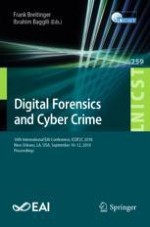2019 | Book
Digital Forensics and Cyber Crime
10th International EAI Conference, ICDF2C 2018, New Orleans, LA, USA, September 10–12, 2018, Proceedings
Editors: Frank Breitinger, Ibrahim Baggili
Publisher: Springer International Publishing
Book Series : Lecture Notes of the Institute for Computer Sciences, Social Informatics and Telecommunications Engineering
